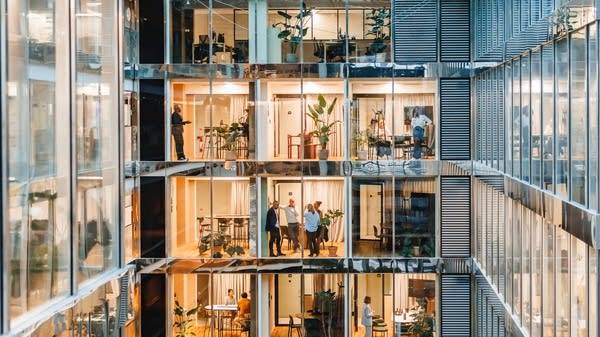Stop talking and face the corner: the new rules of elevators during COVID-19
Elevators have always been awkward. Now they’re a social distancing nightmare.

As offices around the country start to reopen again, many things look very different: Goodbye open floor plans and communal desks, hello Plexiglas dividers and face masks.
Some buildings have installed thermal cameras or touchless entry doors. But there’s only so much you can do to improve safety in one of the most iconic features of modern office life: the elevator.
Richard Corsi, the dean of the Maseeh College of Engineering & Computer Science at Portland State University, is an expert on indoor air quality, so back in January, when he first started worrying about COVID-19, he stopped taking the elevator to his fifth-floor office.
“Well before the stay-at-home order, I was taking the stairs,” he said. “For me, it was not worth the risk.”
There are a lot of things we still don’t know about how people become infected with the virus that causes COVID-19, Corsi said, but being crammed into a little box with no airflow can’t be good.
“An elevator is oftentimes not an environment you can stand far away from people,” he said. “If they’re looking at you and speaking to you, or if they cough, you’re going to get this very high concentration of droplets, even over a short time period.”
That scenario carries the highest risk, he said — more so than pressing a button that someone else touched half an hour ago or inhaling viral particles from a previous rider. It’s most important to minimize exposure to other people in the car. That means passenger limits, masks, no talking, and facing away from each other, which could make for some awkward moments.
“It’s a little weird, I think,” said technician Jordan Schroll, who started going back into work at a Pittsburgh IT firm at the beginning of June. “Everyone’s kind of paranoid about everyone at this point.”
His ride up to the eighth-floor office used to be packed, but now only four people are allowed on each car, and there are footprint stickers in each corner, indicating where to stand.
“I’ve seen some people kind of obviously uncomfortable getting in or out of elevators,” he said. “Or if there’s more than three people in them, no one knows what they should do.”
So far, he said, people have been pretty good at self-regulating. But he can see how things could get ugly, with hurried workers battling it out for the last spot or hogging a car to themselves.
“It’s a ‘Seinfeld’ episode. Basically, we’re living in one,” said Michael Colacino, president of New York City commercial real estate brokerage SquareFoot.
Even before COVID-19, he said, good elevators were a big priority for his clients.
“Standing there waiting for an elevator — it’s like Einstein. It’s like the space-time continuum gets distorted,” he said. “People are going to say, to hell with this. I’m not standing here for 60 seconds.”

With COVID-19 reducing capacity on elevators, many companies in high-rises will have to move to staggered schedules. Tech giant Salesforce has talked about giving workers tickets to ride the elevators at specific times. And more buildings may look to install “destination dispatch” technology that groups riders by destination to make elevators more efficient.
At about $50,000 per car, such upgrades aren’t cheap, though Colacino said there is a low-tech alternative to make people feel better about waiting around: putting mirrors in the elevator lobby. People can distract themselves fussing with their hair or checking out how they look in their new masks.
While elevators are a concern due to the inherent difficulty of social distancing in them, Corsi said they have one saving grace. “The time that you spend in an elevator is usually a pretty short time. And so I don’t think it’s as high of a risk as some other indoor environments,” like say, the office.
A case study of a large outbreak at a call center in South Korea found 94 of the 97 cases of COVID-19 were linked to a single floor of the building where the index patient worked, despite workers having frequent contact in elevators and the lobby.













